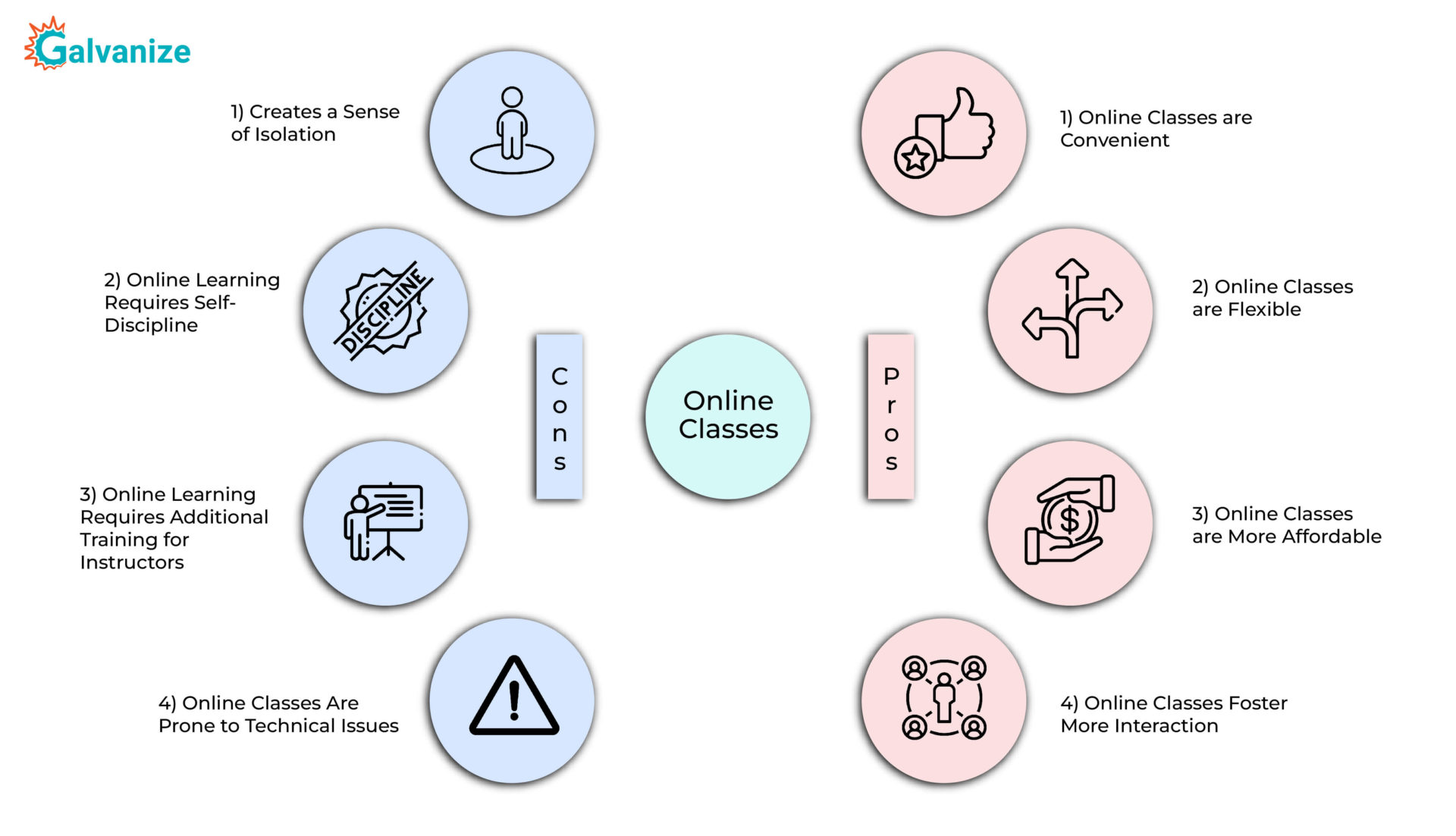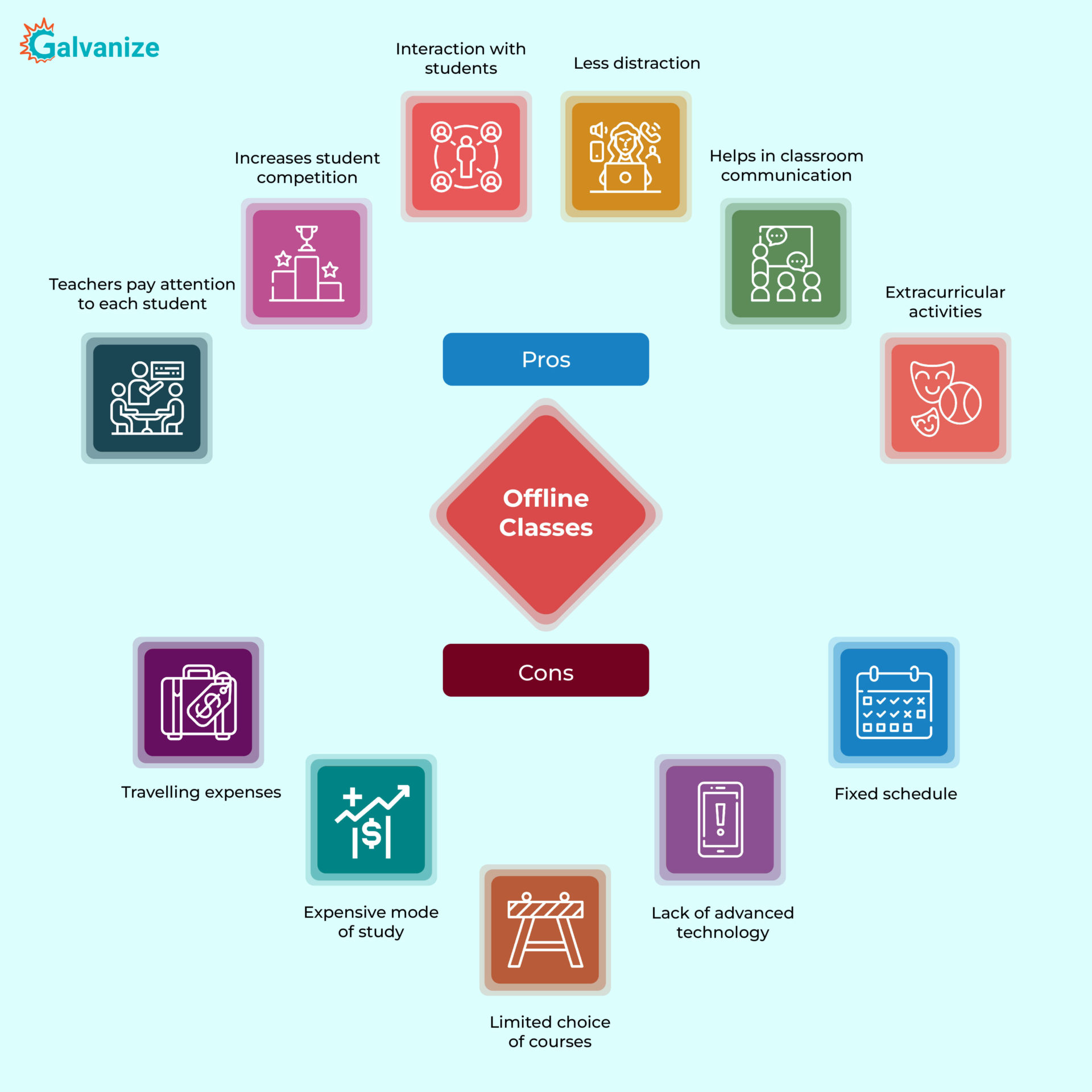
A Complete Guide To
Online Classes vs Offline Classes | Pros and Cons Compared
Chapter 1
Overview
The Covid-19 pandemic caused a seismic upheaval in the global educational system. Because of the implementation of lockdown, physical classrooms were closed, and online education became the new standard. While online learning has kept education alive during these difficult times, it cannot totally replace it.
In this article, we will help you choose the right mode for you by analysing all the factors
How Did Covid Change The Education Industry?
When schools and colleges throughout the world were obliged to shut their doors in order to prevent the spread of the virus, alternate techniques and technologies had to be implemented relatively immediately. Online learning has evolved into a requirement rather than a choice. Here are some changes in the education industry due to COVID:
The Acceleration of Digital Learning
E-learning has been a part of the higher education experience for some years, but never to the level seen during the height of the epidemic. Teaching professionals all across the world have been compelled frequently with little notice to get familiar with a variety of online platforms in order to conduct entire courses completely remotely. As a result, internet platforms such as Google innovated to fulfill this new need, swiftly adding features such as video-conferencing to their Classroom settings service.
Accessibility and Economic Considerations
When considering the impact of COVID-19, there is an economic factor to consider, just as there is in other businesses. The epidemic was a financial blow to institutions, which rely heavily on international students as a source of revenue. As the scope of the situation became clear, many prospective students naturally postponed their enrollments or chose to study from home, anticipating that in-person sessions were unlikely to be available for some time. This has resulted in a monetary loss for educational institutions that produce money, such as student housing.
Changes to the Student Experience
Those who actually moved into university dorms did not have a traditional student experience. Isolation has often taken the role of traditional freshmen activities aimed to enhance social connection and relationship formation. Many students’ mental health has suffered as a result of their separation from their families during this tough period, as well as their sadness at failed academic expectations. Universities’ responses to the crisis have been different, and as a result, the argument over the extent to which educational institutions carry personal responsibility for their students has resurfaced. Students who achieved scholastic success during the epidemic faced a dearth of in-person opportunities to celebrate their accomplishments.
Education as the Answer
Meanwhile, COVID-19 continues to illustrate the value of education. People all throughout the world are anxiously awaiting the release of a successful vaccination that will allow them to resume their lives as they were before the outbreak. The work of scientists and researchers in the field of medicine now has a clear and direct impact on individuals from all walks of life. This enhanced focus may lead to a higher knowledge of breakthroughs in this subject in the future, as well as revitalised respect for the work of researchers in general.
Chapter 2
Online Classes
What is Online Education?
The way education is delivered has permanently altered since the advent of technology. In reality, online education has evolved into a flexible instructional technique of teaching in which students may readily acquire access to study material from the comfort of their own homes. Furthermore, online education gives a fantastic chance for students who are unable to enroll in regular classes, as well as assists students in determining their own study pace.
Online education instills the habit of self-discipline and performance management in pupils while also providing them with access to an infinite amount of educational materials. Students may simply establish their own learning speed as long as they have the necessary equipment and access to a reliable internet connection.
Pros of Online Classes :
Online Classes are Convenient
The first and most obvious advantage of online education is their ease. Traveling to another area before returning home is out of the question. With digital learning, you may now take classes in the comfort of your own home while wearing your favorite slippers. You can look up any videos you may have missed and catch up on lectures later! You might even make the most of your commute time by taking an online course on the way home on the bus or train. You only need internet service and a PC or smartphone to get started.
Online Classes are Flexible
Not only have you saved a lot of time by not having to drive to a physical place to attend a class, but you also have more freedom in picking the best time to study with online courses. You might not be able to locate a face-to-face tutor to teach you Spanish online at 3 a.m., but your possibilities are far wider. Online courses, in the end, allow you to pursue your professional and academic goals on your own time.
Online Classes are More Affordable
The primary benefits of online classes are significant cost savings for the educational organization, which no longer needs to rely on reserving a physical place to offer courses. This translates into more affordable lessons for the student. The requirement to attend a real classroom setting soon raises your expenses as a student. When you attend classes online, you not only save money on the necessities like books and materials, but you also save money on food and travel expenses.
Online Classes Foster More Interaction
Some people believe that conventional learning in a physical location is the most natural and effective method to connect. However, this is not always the case. Everyone is seated front and center! Those who are too afraid to ask a question in front of the whole class can now initiate a live, private conversation with their instructor. If a student is uncomfortable with projecting to the whole class, they can mute their microphone or turn off their camera while still participating in the session.
Cons of Online Learning :
Creates a Sense of Isolation
Everybody learns in their own unique way. Some students are able to work independently, while others feel comfortable in their university community, where they have easy access to lecturers and fellow students. The best part is that online digital classroom platforms have been attempting to bridge such gaps, recreating a sense of community in the virtual environment via the development of a set of technologies that enable learners to actively engage in live sessions.
Online Learning Requires Self-Discipline
Following the previous point, being a member of a community and physically attending sessions improves accountability. If a student does not believe they are receiving adequate instruction, they may lack the self-discipline to be actively involved in the teachings themselves. Moving to virtual, real-time classes rather than merely online courses increases responsibility. Live tests, for example, assist checking to learn in real-time, while breakout areas stimulate group participation. These technologies promote accountability while keeping kids interested.
Online Learning Requires Additional Training for Instructors
To develop a successful online course, online classes need an initial learning curve and more work on the part of the teacher. Instructors must get a thorough grasp of the various methods of teaching and learn in order to avoid just reproducing the physical classroom experience and missing out on all of the additional benefits and tools that eLearning and mixed learning have to offer.
Online Classes Are Prone to Technical Issues
The classic drawbacks of online learning revolve around technical issues. Nothing ruins an online lecture more than problems with audio, video, or connectivity. In the past, students were frequently compelled to download and/or install time-consuming programs or technologies that resulted in an uneven performance. Fortunately, online lessons may now be accessible by just clicking a link without any need to set up anything. Internet connectivity has vastly increased over the world. Furthermore, people’s devices have improved tremendously.
Chapter 3
Offline Classes
What is Offline Education?
Offline education is the conventional complement of online education and the original mode of learning that allows students to engage with their classmates and teachers in person on a regular basis. Offline education is unaffected by technological concerns and gives a wonderful chance for pupils to set and stick to a rigid routine.
Furthermore, offline education enables teachers to watch their pupils’ replies and behavior and address them as needed. As a result, no matter how advanced online education becomes, offline education will continue to play an important part in students’ growth.
Pros of Offline Learning :
Less distraction
According to a study, students prefer offline instruction due to improved classroom engagement and understanding. It is impossible for anyone to sit in front of a screen for a whole presentation without being distracted.
Because the student’s attention span is discovered to be 10 to 15 minutes, lecturers try to abbreviate their videos. So, with offline education, lessons go longer than 15 minutes, which indicates that these programs can capture students’ attention, thereby harnessing the learning experience.
Interaction with students
One significant advantage of offline education is that it encourages teacher-student interaction and extends learning beyond traditional lectures.
Interaction stimulates questions about a certain issue, which aids in greater exploration and learning. If there are engaging sessions, the pupils’ attention span rises as well. Furthermore, pupils who spent less time on social networking websites had a longer attention span.
Increases student competition
As we have seen, offline classrooms improve student engagement, and when such a dynamic environment is formed, students tend to interact with one another, which leads to higher learning.
Researchers whose research supports a well-designed classroom competition have discovered that it improves their learning, self-esteem, and drive.
Helps in classroom communication
In a virtual classroom, you sit alone and there is very little interaction among the students. Communication among students is useful in many ways, resulting in favorable learning results.
This communication is not confined to students alone but also includes substantial teacher-student contact during the learning process.
Teachers pay attention to each student
Interaction between teacher and student is critical in the learning experience. Offline education allows teachers to get to know their students better. Not only that, but knowing what their students are thinking helps teachers design courses.
So there are more vistas when curriculums are tailored to the demands of the pupils. Consider how beneficial it would be if a teacher understood the speed of their pupils and taught them accordingly to make the learning experience go more smoothly.
Extracurricular activities
We are all aware of the value of extracurriculars, and only offline learning can effectively serve them. Some people feel that extracurricular activities have an impact on academic success, yet data shows the exact reverse. The former makes the latter better.
Another study found that adolescents who participate in extracurricular activities for personal reasons improve their social skills by making friends and working together.
Cons of Online Learning :
Travelling expenses
Offline classes have their institutes at one location, and each student must get to their destination in a unique way. This adds hours of travel and preparation time, which is not only costly but also the time that might be used for self-study.
On the other hand, online classes allow students to create a timetable that they can stick to, allowing them to devote more time to their studies.
Fixed schedule
There is no room for flexibility with offline classes because the times are set. Even though the reason is unknown, there is a greater dropout rate among students who work 20 hours per week or full time.
It might be claimed that the class timetable cannot be changed, therefore they have difficulty managing both. According to a study, students’ attendance in online (72 percent) and offline classrooms varied (62 percent ).
Expensive mode of study
Offline study is an expensive method of study, as we previously noted because, in addition to the tuition price, you must pay for boarding and handle the expenditures to travel to campuses.
This is not always possible for everyone to deal with offline education; in such situations, online classes are a preferable alternative. Even the lowest institutions would charge a tuition price of $4000, which is in addition to all other fees.
Lack of advanced technology
Online classes are an excellent way to learn about technological advancements. The usage of laptops or computers, as well as networking with other students through various means, are instructing them on how to use technology and make effective use of it.
Students who have received their education offline since the start may lack exposure to technology, which is a disadvantage in today’s rapidly expanding market.
Limited choice of courses
Offline studies need you to seek the appropriate institute and then examine whether or not you are qualified to attend. Admission is also subject to their qualifying standards. There are so many qualifications merely to get into an offline institute that it creates hurdles to learning.
People are often unable to discover the courses they want to register in, resulting in a setback in which they are forced to study something they do not want to do simply due to the practicalities.
Chapter 3
Online Vs Offline Learning
Online Classes vs Offline Classes Comparison Table :
|
Particulars |
Online Education |
Offline Education |
|
Method of Teaching |
Digitalised tools and methods of teaching |
Traditional tools and methods of teaching |
|
Cost and Time |
Cost-effective and time-saving |
More expensive and time consuming |
|
Location |
Virtual classrooms |
Physical classrooms |
|
Flexibility |
Flexible schedule |
Fixed and strict schedule |
|
Communication |
Communication and collaboration happens digitally |
Communications and collaborations happen face-to-face |
|
Type of Approach |
Facilitation and asynchronous approach |
Instructional and synchronous approach |
|
Pace of Learning |
Students largely determine the pace of learning |
Teachers largely determine the pace of learning |
Online Classes vs Offline Classes: Which One Should You Choose?
Here are some key factors which will help you choose the right option for you:
Mode of Education
Teachers can simply educate their pupils using virtual classrooms when it comes to digital classes. Students may quickly access instructional materials from any location as long as they have sufficient internet connections. Teachers in online classrooms have access to a variety of online learning materials, such as videos, audio, virtual conference rooms, animations, virtual whiteboards, and live chats with students.
Offline lessons, on the other hand, offer students with a hands-on learning environment inside the confines of a real classroom. It enables students to communicate intimately with their lecturers as well as actively participate in live debates and discussions. Students can also partake in leisure activities such as art and physical training, which add to the student’s total mental and physical growth.
Accessibility
One of the most significant advantages of online classes is their availability from anywhere around the globe. Students may simply log in from anywhere and access study materials from the comfort of their own homes. Apps like Zoom and Microsoft Team have made it possible for students to attend lectures without leaving the comfort of their own homes. Furthermore, students do not suffer any transportation costs. As a result, online programs have the particular benefit of providing location flexibility.
Offline lessons, on the other hand, necessitate students traveling to the site of their academic institution. Teaching occurs in a specific place, such as a lecture hall or a physical class.
Time Management
Students who take online programs encounter a significant time management difficulty. Online students are frequently sidetracked by a plethora of work and lack a healthy timetable. Because online classes allow for self-paced study, students may lack a set timetable and succumb to the habit of procrastination.
In the event of offline lessons, students must follow a rigid timetable established by the lecturers. Furthermore, because there is synchronous learning, students must finish their work and assignments on time. Not to add, there is less distraction for pupils within the walls of a real classroom, and kids learn to complete their assigned work on time.
The flexibility of Classes
Flexibility is a major plus point in online classes. It enables pupils to determine their own learning speed without feeling rushed. Students may easily attend classes when it is convenient for them since they have availability to video recordings and online reading material. It also allows pupils more time to comprehend study material and finish work or research at their own speed.
When it comes to offline education, there is some rigidity. Students are expected to be on time for their lectures or sessions because there are no pre-recorded films or notes readily available to them. As a result, students are forced to adhere to a planned and rigid timetable established by their educational institute.
Technical Issues
Technical problems are usually a barrier with online classes. Access to appropriate technological equipment such as cameras, microphones, headphones, and laptops, as well as a reliable internet connection, is required for online classes. Furthermore, technological obstacles such as a sluggish internet connection or a lack of sufficient technical infrastructure may obstruct seamless learning. Students may have problems attending live lectures, accessing videos, or taking notes online.
Technical problems are rarely a danger to offline classes. Students and instructors are not expected to be extremely tech-savvy, and because most learning takes place in the physical classroom, technological concerns are not a big concern, with the exception of any sessions that need presentations or computers.
Practical Learning
Online education is solely theoretical and is conducted exclusively online. This makes it difficult for pupils to participate in the practical parts of learning, which are equally vital parts of education. Chemistry, biology, physics, art, and sports all encourage students to be physically present in order to conduct live experimentation or actively engage in the activity.
Unlike online classes, offline classes offer a stimulating setting that incorporates both academic and practical components of learning. This adds to the pupils’ general intellectual and skill development. Practical learning helps you to learn and adapt rapidly to daily obstacles and settings, as well as have a deeper grasp of teachings.
FAQs :
Are online classes good or bad?
Online classes are generally less expensive than regular classes and may be completed at the student’s own speed. The convenience of online classes can also be advantageous for middle and high school students.
Is learning online effective?
In the proper hands, online learning can be a highly strong and successful medium. It can help kids study at breakneck rates and perhaps save them a significant amount of time. The usage of multimedia elements is one of the primary reasons that online learning has become so effective. This allows pupils to grasp concepts quickly and simply.
How do I concentrate in online classes?
Keeping all distractions at bay is critical regardless of whether you learn online or offline. To begin, make sure that your television is turned off. Attending online lessons in a quiet and separate study area with a seat and table and no beds around will help you concentrate better on your courses.
Do students prefer online or offline learning?
While the majority of students have come to choose online learning techniques due to their obvious benefits, offline learning also offers certain advantages. The mixed learning approach is being viewed as a wonderful solution for reaping the benefits of both methods.
Why do students fail online classes?
Some students fail online classes because they are unfamiliar with the material. They may believe that online programs are simpler than classroom ones, but in truth, these courses need more discipline and, in many cases, more work.
Written by Madhurjya Chowdhury
Guided by Pavitra Srinivasan and the Galvanize In-house Experts














Thanks so much for this wonderful composition that means in my school the topic was given to write about offline classes are better than online classes so I would like to choose this galvanize website all the time every time on the spot the writer is a very good person who writes a very well about the things I would like to appreciate even her and even who help her thank you once again this made me get 30 marks in my unit test 1 2022 thank you thank you thank you a lot especially special thanks for @Madhurjya Chowdhury and @Pavitra Srinivasan.
Great read!! Thanks for sharing such a great blog.
I have been homeschooling my children and recently they have joined online school an they are doing well.